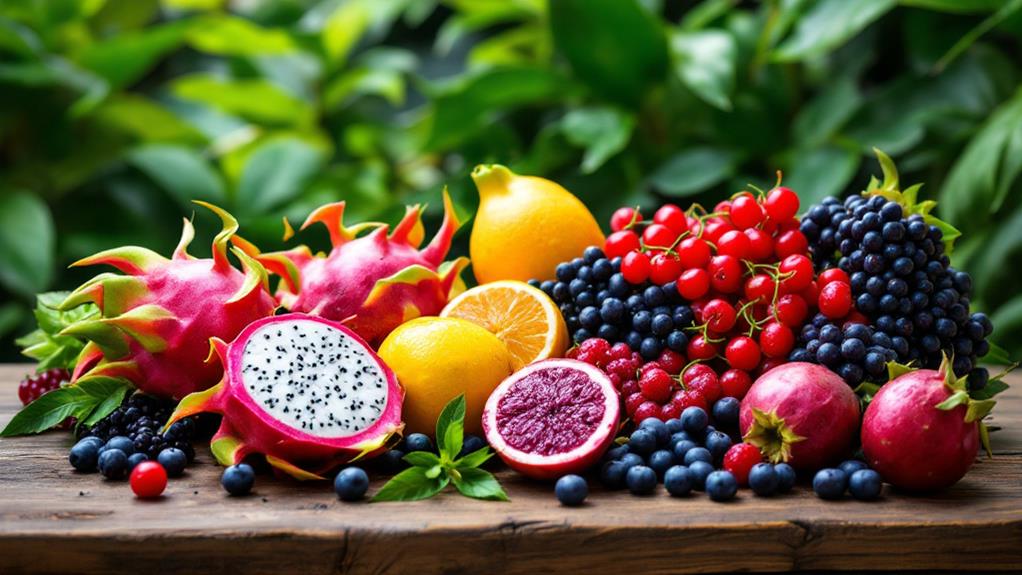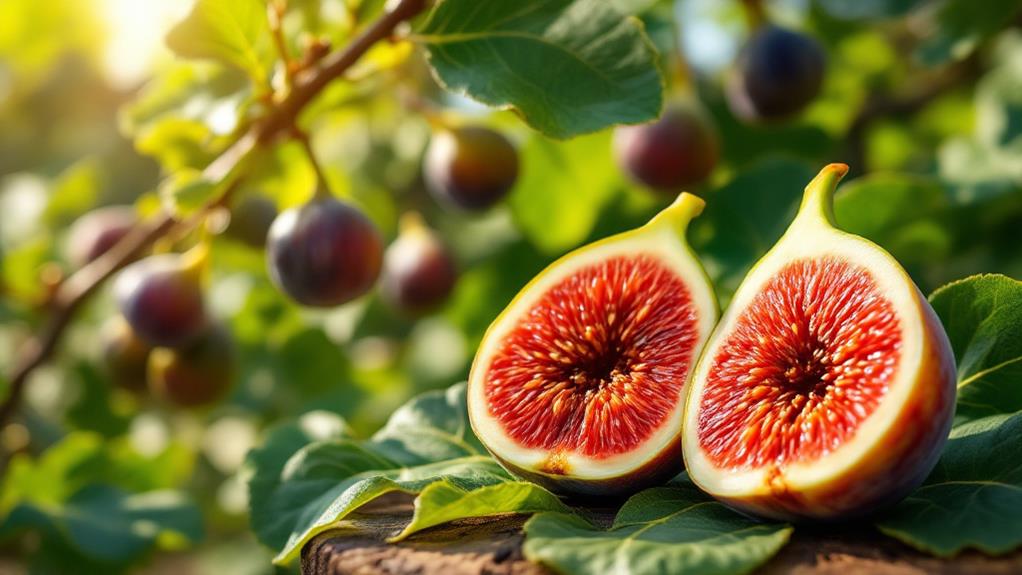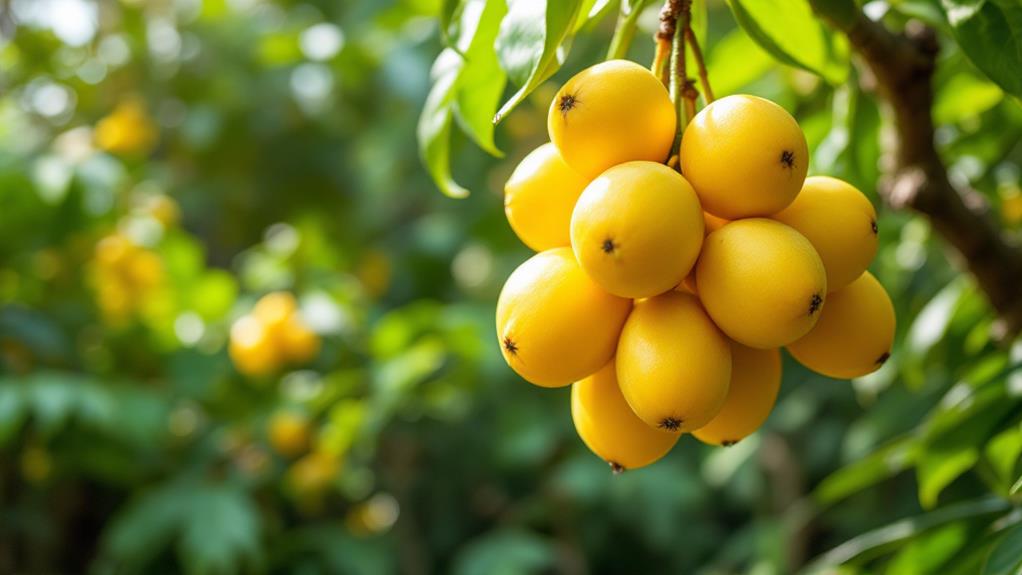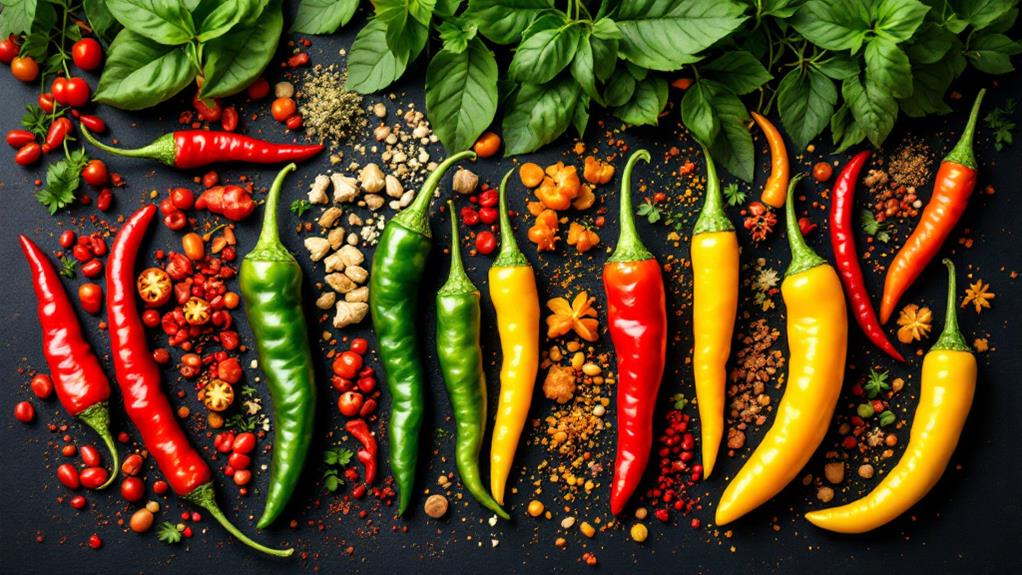European Fruits: Interesting Facts and Their Cultural Significance
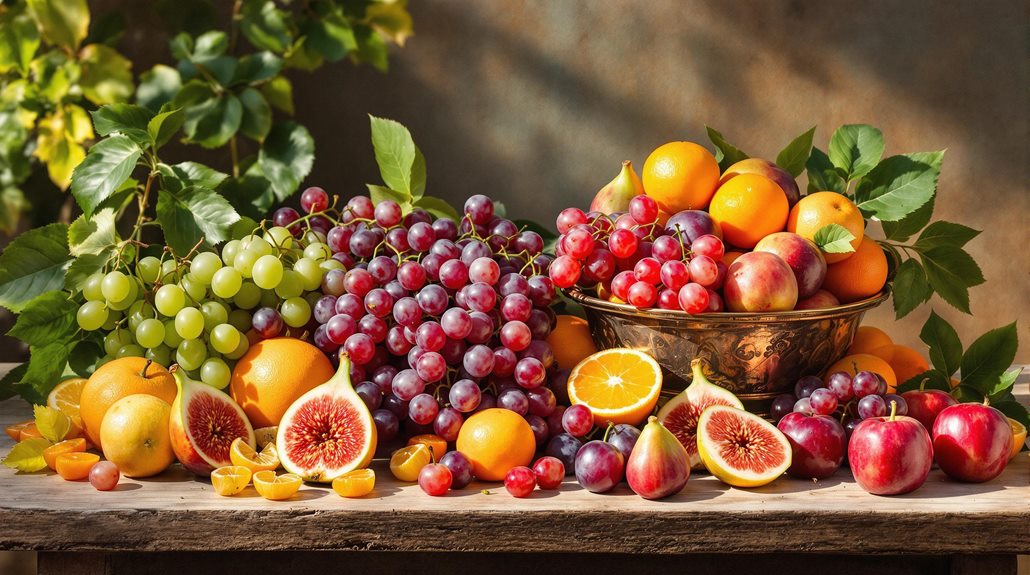
European fruits are loaded with intriguing history and cultural weight. Apples, cultivated since 6500 BC, embody prosperity and abundance. In ancient times, grapes symbolized wealth and fertility, linking to gods like Dionysus, and now, they're emblematic in literature and art. Citrus fruits, introduced during the medieval period, transformed European cuisines, signifying luxury. Gooseberries and currants have spiced up recipes since the 16th century. Not just flavors, these fruits play key roles in festivals like La Rioja's Grape Harvest and the UK's Apple Day. Art, traditions, and health benefits entwine beautifully in every bite. Uncover even deeper stories and facts.
Cultural Significance of European Fruits
Throughout history, European fruits have played a crucial role in shaping cultural narratives and practices. When you think about apples and grapes, their cultural significance becomes clear. Apples, cultivated since 6500 BC, aren't just fruits; they represent prosperity and abundance, deeply rooted in historical narratives. Grapes have been cherished by ancient civilizations, including the Egyptians and Romans, symbolizing wealth and fertility. These fruits have been more than food—they've been pivotal in rituals and celebrations, marking them as symbols of cultural heritage.
Pomegranates, originating from the Mediterranean, hold a unique place in Greek mythology, symbolizing fertility and beauty. Their cultural significance extends to religious contexts within Judaism and Christianity. You might find it fascinating that pomegranates are believed to contain 613 seeds, aligning with the commandments of the Torah, highlighting their spiritual importance.
Gooseberries and currants, integral to European cuisine since the 16th century, have enriched culinary traditions. Gooseberries were historically used to improve the flavor of fatty meats, while currants have woven themselves into myths and recipes. Their presence in European history showcases how fruits can influence both cultural and culinary landscapes, making them indispensable in Europe's rich tapestry.
Citrus Fruits in European History
As traders introduced citrus fruits to Europe from Asia during the medieval period, they transformed European culinary practices with their tangy flavors and preservation properties. You'd find that lemons and oranges were more than just ingredients; they were symbols of luxury and status. Elite feasts showcased these fruits, impressing guests with their lively colors and exotic flavors.
Citrus fruits weren't merely decorative. Their high acidity improved marinades and sauces, adding depth to European cuisine. Plus, the vitamin C content was a game-changer, especially for sailors. Imagine the relief when scurvy, a dreaded disease, could be warded off by simply consuming these fruits.
During the Renaissance, citrus fruits carved their niche in desserts and beverages. Their sweet and sour profiles became indispensable, creating a lasting impression on culinary traditions. As the demand grew, citrus orchards sprang up in Italy and Spain, where the climate favored their growth. You could say this was the beginning of a deeper understanding of their nutritional benefits and versatility in cooking.
Grapes: Symbolism and Tradition
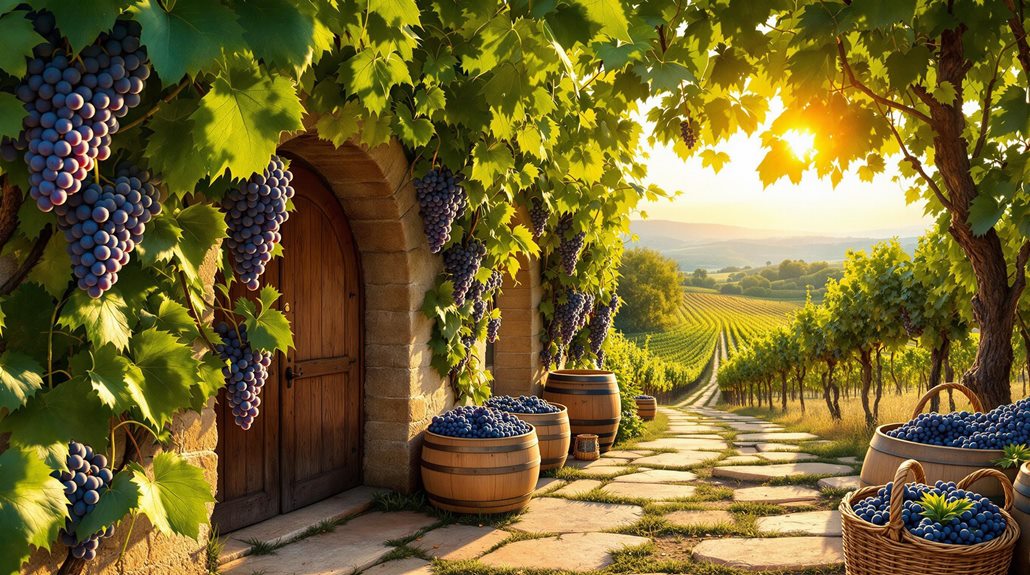
Grapes have long captured the human imagination, embodying prosperity and abundance across diverse cultures. In ancient Roman and Greek times, grapes symbolized wealth and were closely linked to deities like Dionysus and Bacchus. These gods of wine and celebration embodied the joy and luxury that grapes represented. As a reflection of social status, artistic depictions of grapes were popular among the affluent, showcasing opulence and luxury. If you wanted to convey wealth and sophistication, owning grape-themed artworks was a clear statement.
Fast forward to the Victorian period, and grapes took on new meanings, symbolizing friendship, connection, and determination. They transcended mere consumption, becoming a way to express cultural significance and social bonds. This shift highlights the fruit's versatility in symbolism.
In religious contexts, grapes have played crucial roles, often appearing in biblical references. They symbolize fertility and divine blessings, especially through the lens of wine and communion. This sacred connection underscores the importance of grapes beyond their physical form.
Interestingly, the term "grenade" comes from the Spanish word for pomegranate, drawing a symbolic link between grapes and military imagery due to their numerous seeds. Grapes continue to hold rich, diverse meanings across history.
Nutritional Benefits of European Fruits
The rich symbolism of grapes offers just a glimpse into the multifaceted world of European fruits, which are not only steeped in history but also packed with nutritional benefits. From apples to citrus fruits, these natural gems are essential for maintaining your health. Apples and pears are rich in dietary fiber, aiding digestion and promoting gut health. By including these fruits in your diet, you can support a healthy digestive system.
Vitamin C is a standout nutrient in European fruits, especially in citrus varieties like oranges and lemons. This critical vitamin boosts immune support and acts as a powerful antioxidant, protecting your body from harmful free radicals. Berries such as strawberries and blueberries are also antioxidant powerhouses, helping you combat oxidative stress and potentially lowering your risk of chronic diseases.
| Fruit Type | Key Nutrients |
|---|---|
| Citrus | Vitamin C, Antioxidants |
| Berries | Antioxidants |
| Stone Fruits | Potassium, Vitamins A & C |
Stone fruits like cherries and plums offer potassium and vitamins A and C, which are crucial for cardiovascular health and maintaining skin integrity. Grapes, especially red ones, are rich in resveratrol, known for its heart health benefits and anti-inflammatory properties. Cherish the nutritional wealth of European fruits and improve your wellbeing.
Seasonal Festivals and Rituals
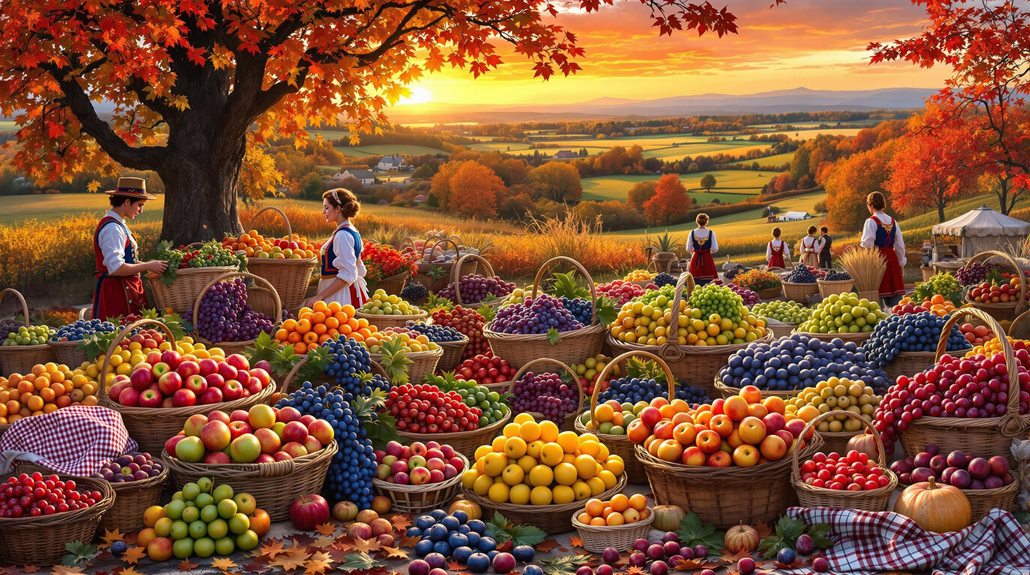
Throughout Europe, seasonal festivals offer a lively celebration of the region's rich fruit harvests, inviting you to witness the cultural and agricultural heritage directly. In Spain, the Grape Harvest Festival in La Rioja is a must-see, where you can engage in grape-related activities and savor local wines. This festival highlights the importance of grapes to the region's identity. In the UK, October brings Apple Day, encouraging you to investigate the diversity of apple varieties. You'll find communities coming together for apple picking and cider making, emphasizing the apple's significance in British culture.
Head to France in August for the Fête de la Mirabelle in Lorraine, where you'll enjoy parades, music, and tastings of the sweet mirabelle plum. This festival honors the plum's place in local tradition. Italy's Sagra dell'Uva in Marino, celebrated each September, invites you to indulge in wine tastings and traditional music, marking the grape harvest with a communal feast.
Though not in Europe, Tunisia's Pomegranate Festival in Gabès celebrates the fruit's cultural ties through art and culinary events, showcasing a shared Mediterranean appreciation for seasonal fruits. These festivals make European fruit culture come alive.
Art and Literature Inspirations
While festivals bring fruit culture to life through lively celebrations, art and literature capture their essence in more enduring forms. Imagine standing before Sandro Botticelli's "Madonna of the Pomegranate," where the fruit symbolizes fertility and beauty, showcasing its deep cultural resonance. You might notice how fruits and vegetables, like grapes, weave their way into art and literature, embodying themes of abundance and connection. Grapes are not just tasty; they're tied to the god Dionysus in Greek mythology and later appear in Christian iconography, representing wine and prosperity.
In Victorian literature, grapes took on new meaning, symbolizing friendship and the joy of shared meals. Think about the gatherings filled with laughter and conversation, where such fruits became a metaphor for connection. Beyond paintings and stories, fruits have inspired decorative patterns since the 15th century. Picture the intricate designs in Oriental carpets, where pomegranates and other fruits create lively motifs.
Interestingly, the word "grenade" comes from the pomegranate, a reflection of its historical and cultural significance. You see, fruits and vegetables aren't just sustenance; they're woven into the very fabric of European art and literature, enriching it with layers of meaning.
Agricultural Practices in Europe
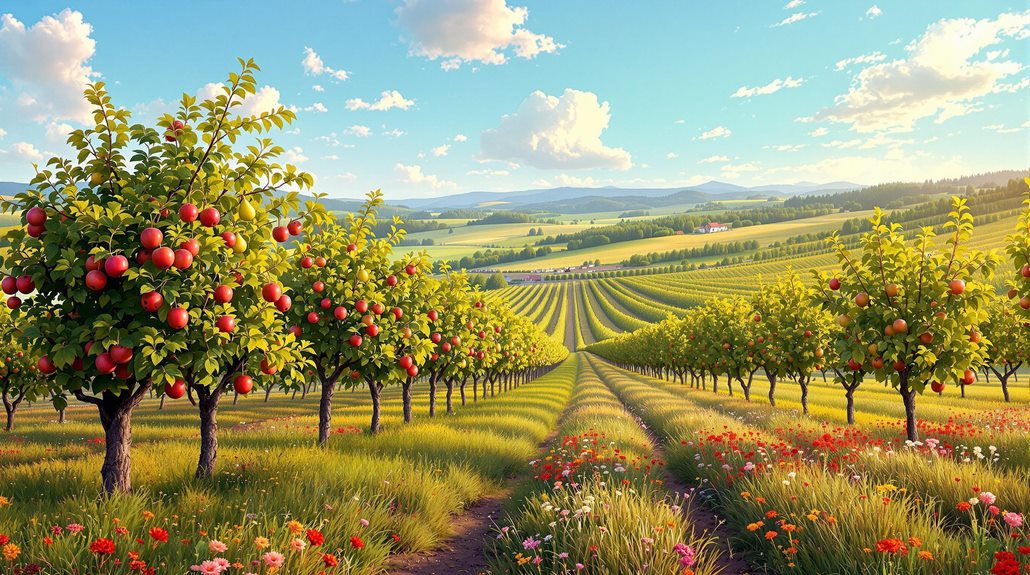
Many European agricultural practices highlight the importance of tradition, focusing on flavor and quality rather than sheer yield. You'll find that this dedication results in a rich variety of fruit, each boasting distinct tastes and potential medicinal properties. The European Union enforces strict regulations like the Appellation d'origine contrôlée (AOC) system, ensuring that these fruits adhere to traditional methods, preserving their quality and cultural significance.
Consumers in Europe often prefer seasonal farming, emphasizing locally sourced, in-season fruits. This practice not only improves flavor but also supports local economies and reduces environmental impact. To promote sustainable farming, many European countries invest in organic practices and biodiversity, which play a vital role in healthier fruit production.
Here's a quick overview of some key agricultural practices in Europe:
| Practice | Benefit |
|---|---|
| Traditional methods | Maintains flavor and quality |
| Seasonal farming | Improves flavor; supports local economies |
| Sustainable techniques | Reduces environmental impact; healthier fruits |
Fruits hold a special place in European culture, often celebrated through festivals that honor local harvests. These events reinforce community ties and promote appreciation for regional agricultural heritage. As you investigate these practices, you'll notice how deeply intertwined they are with Europe's cultural fabric.
Challenges and Innovations in Cultivation
A variety of challenges and innovations are shaping the cultivation landscape for fruits in Europe. As a grower, you're likely aware of the ongoing battle against drought conditions. Modern irrigation techniques have been a game-changer in this regard, offering better water management solutions that help your crops thrive even during dry spells. You've probably also noticed the shift towards integrated pest management (IPM). By minimizing chemical use, IPM allows you to maintain high yields and fruit quality without compromising the environment.
Climate change presents another set of challenges. Researchers are actively developing climate-resistant fruit varieties through focused breeding programs. These efforts aim to guarantee your crops can adapt to Europe's ever-changing climate. To further optimize cultivation, advanced monitoring technologies, like drones and soil sensors, provide you with real-time data on crop health, enabling more precise management.
Sustainability is no longer just a buzzword. Organic farming and agroforestry are gaining traction across Europe. By embracing these practices, you're not just promoting biodiversity, but also reducing your environmental footprint. In this evolving landscape, staying informed of these innovations can help you navigate the challenges of fruit cultivation successfully.

